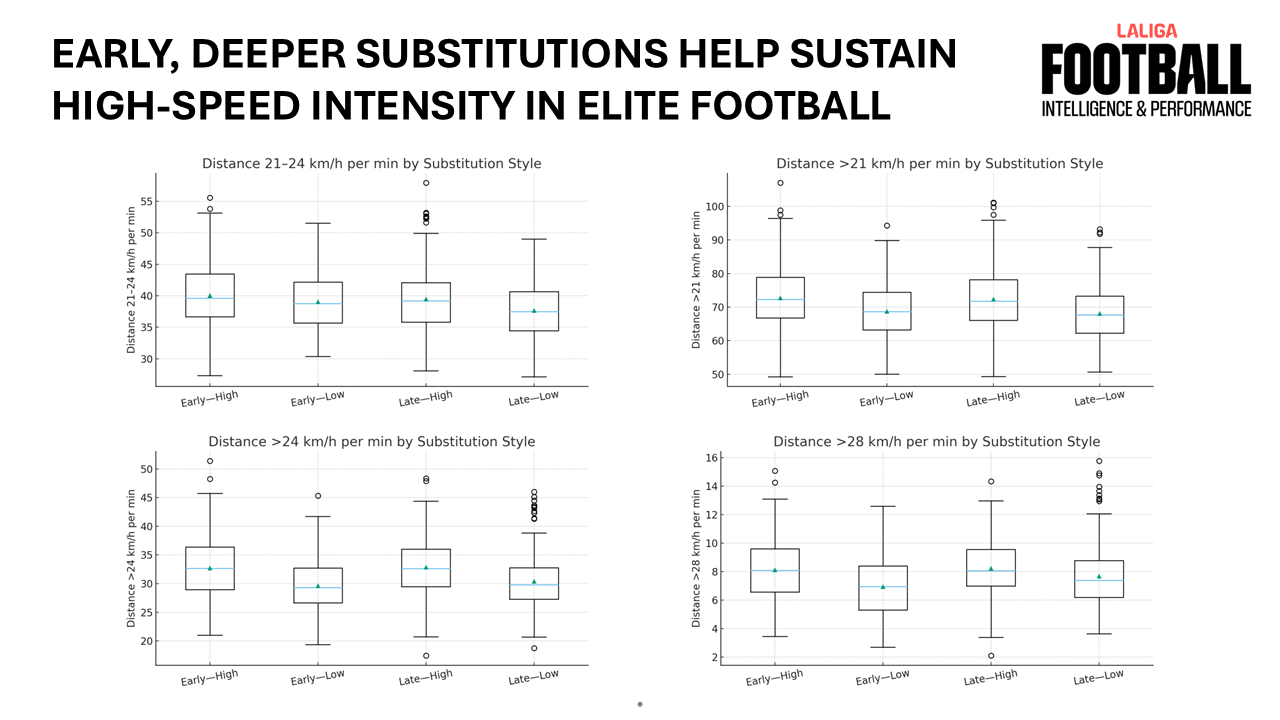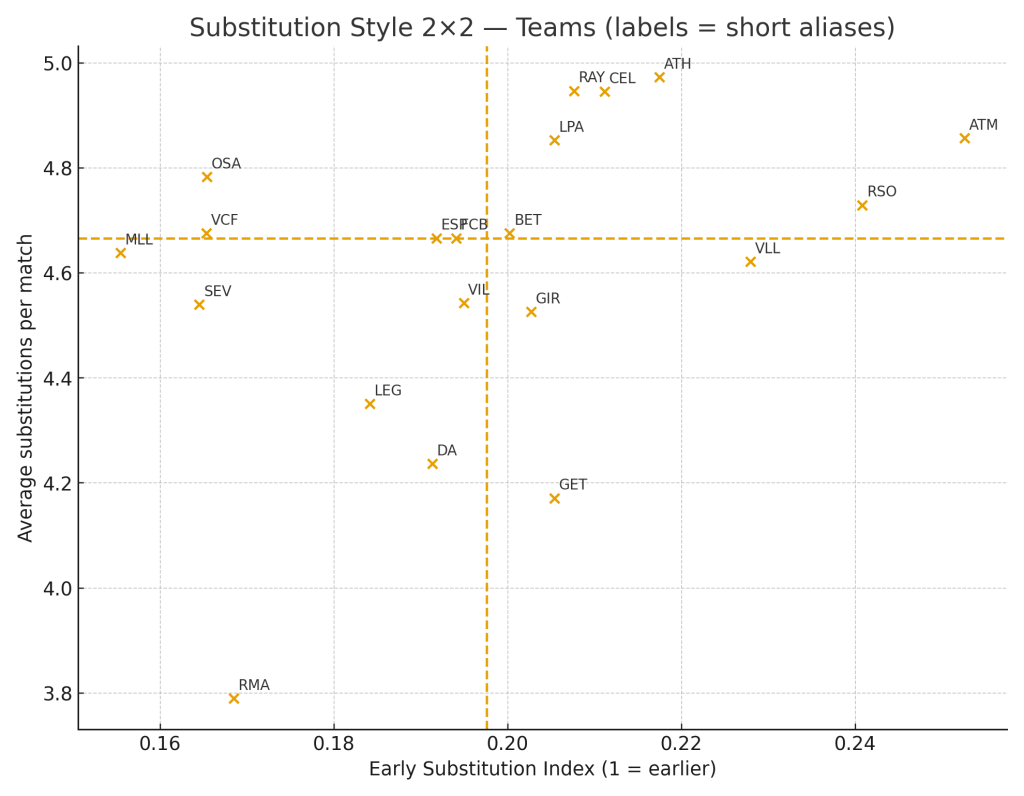
10 Oct Stop saving your substitutions
Earlier, deeper substitutions sustain high-speed intensity
Evidence from LALIGA EA Sports 2024/25 (full season).
A real sideline question
Minute 68. Your GPS board shows high-speed efforts fading. You’ve used two substitutions (subs); staff are split: hold the rest for the last push, or invest now with a double change? Which approach actually helps your team keep intensity alive?
Data scope. All analyses use LALIGA EA Sports, 2024/25 full season (entire competition).
Research by the Football Intelligence & Performance Department at LALIGA.
Why we asked (Introduction)
The five-sub era changed how we manage energy, momentum and risk. Common touchline wisdom says: “save substitutions for the last ten.” We pressure-tested that habit:
Do teams that change earlier—and use more of their bench—sustain higher intensity per minute across the match?
(Per-minute normalisation lets us compare fairly regardless of total/effective time.)
How we studied it (Methods, coach’s version)
Dataset & variables
- Competition: LALIGA EA Sports 2024/25, full season.
- Physical outputs (all per minute): Distance 21–24 km/h, >21 km/h, >24 km/h, >28 km/h.
- Timing notes: Substitution minutes are whole-minute values and can exceed 90’ (stoppage). Concussion-related sixth substitutions exist in 24/25; we exclude them from minute-level timing to avoid partial timestamp bias.
The four substitution styles (football language, integrated with team examples)
- Early—High (renew soon and a lot).
Mindset: proactive energy management. Pre-commit an early refresh (often a planned double change before 65’) to keep pressing, counter-pressing and depth runs alive; use the bench to refuel the top speed bands while the match is still evolving.
2024/25 examples: Atlético de Madrid, Real Sociedad, Athletic Club, RC Celta, Rayo Vallecano, UD Las Palmas, Real Betis. - Early—Low (touch early, but sparingly).
Mindset: a surgical tweak—one early sub to fix structure or matchup—then trust the starting XI. Risk: intensity can dip late if the bench isn’t used to refuel speed.
2024/25 examples: Real Valladolid CF, Getafe CF, Girona FC. - Late—High (hold, then many late).
Mindset: conserve windows for a stacked push around 70’–80’ (double/triple). Gains are real, but usually smaller per minute than Early—High because the early fade isn’t countered soon enough.
2024/25 examples: FC Barcelona, RCD Espanyol de Barcelona, Valencia CF, CA Osasuna. - Late—Low (continuity first).
Mindset: ride the XI, minimal disruption. Protects tactical stability but tends to under-refuel high-speed bands; relies more on control and slower tempo than on bursts.
2024/25 examples: Villarreal CF, Deportivo Alavés, CD Leganés, Real Madrid, Sevilla FC, RCD Mallorca.
(Classification is median-based and descriptive—not a value judgement.)

Statistics you can trust
- Group comparisons: Kruskal–Wallis and Mann–Whitney with FDR correction.
- Match-level regressions (robust SEs) controlling for number of substitutions and minute of last change.
What we found (Results)
1) The pattern is clear—across all four per-minute metrics
Teams in Early—High consistently show higher per-minute intensity than Late—Low.
The effect is small but stable, and strongest in the faster bands (>24 and >28 km/h per minute).
2) Both when and how many matter
- An earlier last change is linked to higher per-minute intensity.
- More total subs are linked to higher per-minute intensity.
- Even after controlling for both, Early—High teams remain above Late—Low on all four metrics.
3) What this does not claim
This is associational, not causal. Scoreline, opponent style, red cards and tactical intent still matter. But the direction is robust: locking in earlier, deeper rotations aligns with sustaining high-speed output.
What to do with it (Applications you can use this week)
A) Build an Early—High game model (when context allows)
- Pre-commit windows: plan an “energy window” before 65’; don’t fear a double change.
- Swap functions, not just names: design role chains (e.g., pressing 8 + wide runner) so intensity roles persist regardless of personnel.
- Fuel the top bands: treat >24 / >28 km/h exposure as a team resource; use subs to refuel it while there’s time to change patterns.
B) Train for impact substitutions
- Prime the bench: micro-dose high-speed in MD- sessions for likely substitutes so they can hit >24/>28 from minute one.
- Action-ready warm-ups: short, position-specific priming with a first-sprint cue.
- Objective triggers: link calls to live intensity KPIs (e.g., PPDA spike + team HSR dip → pull the window forward by 5’).
C) When you must go Late—High
If match state forces you to wait, stack the final window with complementary pairs (ball-progressor + runner beyond). Expect smaller per-minute gains than Early—High; you’re trading toward tactical freshness more than pure speed-band renewal.
Limitations (read this like a pro)
- Observational data: we adjust for simple confounders, but we don’t randomise substitution strategies.
- Context sensitivity: scoreline, opponent quality and congestion can override an early plan.
- Minute rounding/extra-time: timestamps are whole minutes; conclusions were robust to that choice. Concussion-related sixth subs were excluded from timing detail.
Bottom line (Coach’s checklist)
Default bias: when uncertain, earlier and deeper beats later and lighter for sustaining high-speed intensity.
Before kick-off: Where are our two early windows?
In-match: Monitor team >24 / >28 km/h per minute. If it fades early, bring the window forward.
Design changes as functions: runner + presser pairs keep intensity roles alive.


